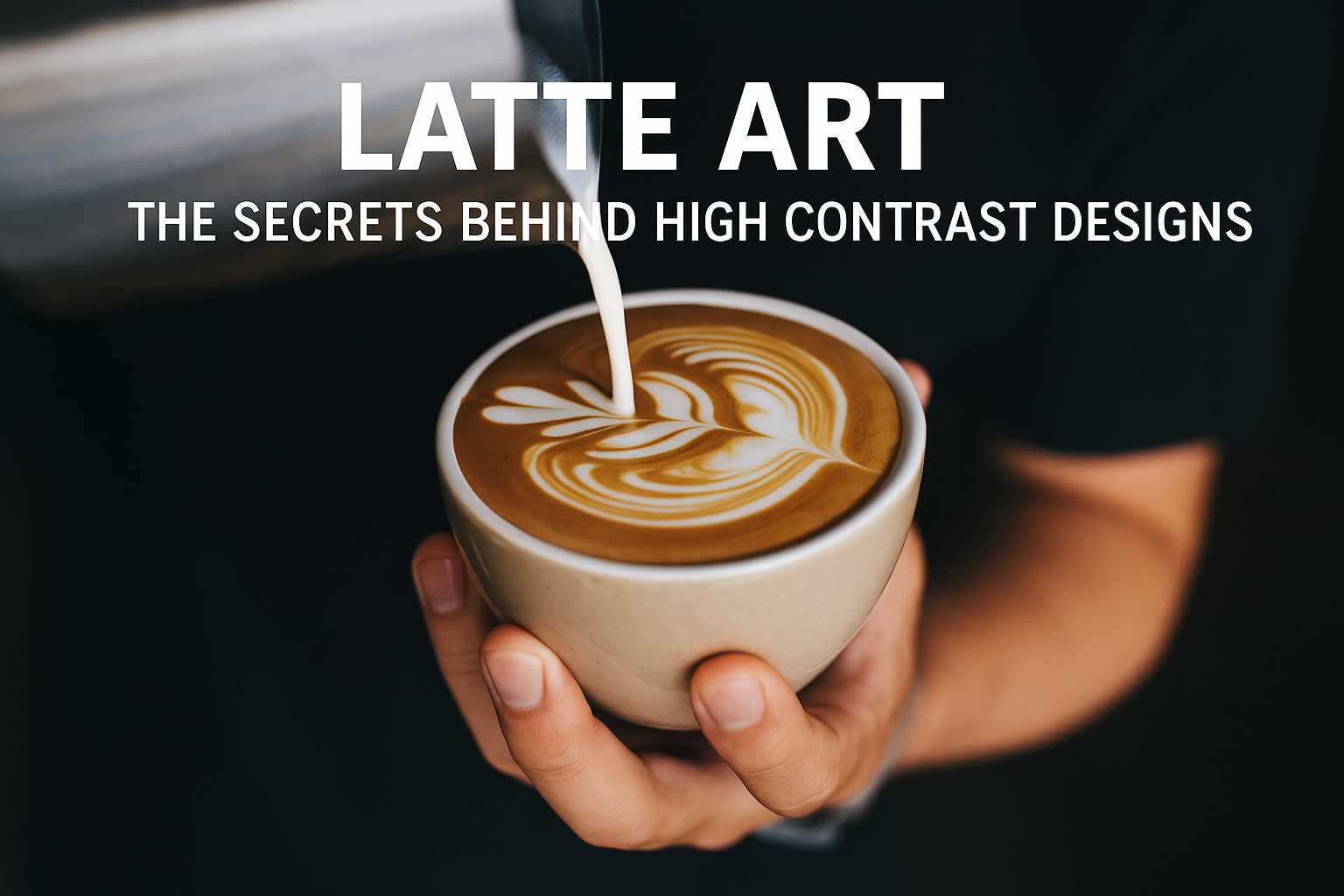In the world of latte art, a design’s beauty doesn’t only come from its shape — it comes from its clarity. A perfect heart or rosetta means little if it’s barely visible.
What separates good latte art from great latte art is contrast — the bright, defined white of the milk against the rich brown of the espresso crema.
High contrast latte art makes your designs pop. It enhances visibility, precision, and aesthetic appeal. It’s also a sign that you’ve mastered core barista fundamentals: espresso extraction, milk texturing, pouring speed, and flow control.
In this complete guide, we’ll explore the key elements that influence contrast in latte art, common problems that reduce visibility, and advanced tips to help you pour bold, clean, high-contrast designs every time.
Let’s help your latte art stand out in every cup.
What Is Contrast in Latte Art?
Contrast refers to the visual difference between the white milk foam and the brown espresso crema. The more distinct the white shape appears against the dark background, the higher the contrast.
High contrast designs have:
- Bright white shapes
- Clean edges
- Deep brown backgrounds
- Sharp definition between foam and crema
Poor contrast makes the design look faded, mushy, or invisible. High contrast, on the other hand, creates a striking visual impact — one that communicates skill, precision, and attention to detail.
Why High Contrast Matters
1. Visual Impact
A high-contrast pour looks sharper, more professional, and more appealing to customers. In competitions and social media posts, contrast is what makes latte art visually “pop.”
2. Technical Mastery
Good contrast reflects mastery of:
- Milk steaming
- Espresso extraction
- Pouring technique
- Timing
Each of these must work together in harmony to create a visible design.
3. Consistency
Being able to create consistent contrast cup after cup is one of the signs that you’re ready to move from beginner to professional.
The Four Core Elements of High Contrast
Let’s break down the key factors that influence contrast in latte art and how you can master each one.
1. Crema Quality
Your espresso’s crema acts as the canvas for your latte art. If the crema is thin, weak, or broken, it will not support the milk foam visually.
How to Improve Crema Quality:
- Use fresh, high-quality coffee beans
- Fresher beans = more crema-producing oils and gases
- Dial in your grind and dose properly
- Aim for a fine grind that creates a consistent extraction
- Pull your shot at the right temperature and pressure
- Under-extracted = pale crema
- Over-extracted = thin or bitter crema
- Use espresso within 10 seconds of pulling
- The longer you wait, the more the crema dissipates
A thick, golden crema gives your milk something to float on and contrast with. Think of it as your background layer — get this wrong, and the art won’t hold.
2. Milk Texture
To sit on top of the crema, the milk needs to be properly steamed. This means creating microfoam — smooth, shiny milk with no visible bubbles.
How to Create Perfect Microfoam:
- Use cold whole milk — higher fat content helps with texture and sheen
- Introduce air (stretching) for only 1–2 seconds
- Submerge the wand to create a vortex (emulsifying the foam)
- Steam to 60–65°C — not hotter, or the foam breaks down
- Swirl and polish the milk before pouring to maintain uniformity
Foam that’s too thick will sit heavily, making the design look clunky or distorted. Foam that’s too thin or bubbly will dissolve into the espresso.
3. Pouring Technique
Even with great espresso and milk, your pour determines how and where the foam lands on the crema — and how it appears.
Key factors include:
- Pour height
- Start high to integrate milk with crema
- Drop low when you want to place foam on top
- Flow rate
- Control the stream — too fast = flooding, too slow = fading
- Pitcher position
- Stay centered, pour straight
- Draw-through
- A clean, confident finish line helps define the shape
The moment when your pitcher lowers to the crema is the moment contrast is born. If you drop too soon or too late, the design won’t appear crisp.
4. Timing
Pour your milk immediately after steaming. Wait too long, and the foam separates. Pour your espresso immediately after pulling — don’t let it sit.
Fresh espresso + fresh milk = maximum contrast and flow.
How to Improve Each Design with Better Contrast
Hearts
- Begin with a slow, high pour to mix base milk with crema
- Drop low and increase flow only when the cup is ½–¾ full
- Keep your pour still to avoid wobbly edges
- Pull the line through the center smoothly
Tulips
- Focus on clean starts and stops for each stack
- Keep the milk stream consistent in size
- Avoid swirling the pitcher mid-pour
Sharp, even layers create stunning contrast in tulips when done right.
Rosettas
- Begin with a high pour to build contrast
- Use a steady, rhythmic wiggle — not too wide
- Keep the stream centered as you move backward
- End with a straight, quick pull-through
Rosettas with good contrast show bold leaves with clear definition.
Common Problems That Kill Contrast (And Fixes)
Problem 1: Pale, Weak Designs
Cause: Weak crema or overly thin milk
Fix: Pull espresso fresh, dial in grind, texture milk better
Problem 2: Art Sinks into the Coffee
Cause: Pouring too high during the design phase
Fix: Lower the pitcher once you start your art
Problem 3: Milky Blobs with No Shape
Cause: Foam too thick or flow too fast
Fix: Steam smoother milk and slow your pour speed
Problem 4: Edges Are Fuzzy or Unclear
Cause: Wiggling the pitcher or moving off-center
Fix: Keep your wrist stable and pour straight
Advanced Tips for Maximum Contrast
Use Lighter Roasts with Good Crema
While darker roasts produce more crema, it’s often thinner. Lighter espresso roasts can produce dense crema that enhances contrast — especially if brewed with precision.
Tilt the Cup Slightly Toward You
This helps the milk flow to the center and makes controlling the contrast easier, especially for complex designs.
Keep Your Milk in Motion Before Pouring
Swirl your pitcher while walking to the cup. Stagnant milk separates — which kills flow and contrast.
Stop Steaming at the Right Temperature
Too-hot milk loses sheen and creates flat foam. Keep it between 60–65°C for perfect microfoam that supports visual clarity.
Practice “Zero Art” Pours
Pour multiple drinks focusing only on contrast — no fancy shapes. Practice:
- Integrating milk slowly
- Finding the exact moment the white foam begins to show
- Stopping just before flooding the crema
This builds precision and teaches you how to place foam, not just pour it.
How to Practice High-Contrast Pours
- Use dark espresso shots with well-formed crema
- Practice in white cups to monitor contrast clearly
- Record your pours and compare the brightness and visibility
- Pour slowly at first — speed comes later
- Rate each pour on a contrast scale (1–10)
With focused repetition, you’ll notice your designs looking crisper and more professional each day.
When to Break the Rules (And Still Keep Contrast)
Once you’ve mastered the basics, you can experiment:
- Use colorful cups for visual flair, but make sure the contrast still holds
- Try double espressos for deeper crema, especially in larger drinks
- Play with pitcher spouts — narrow ones help with definition
The key is to stay in control. Contrast is a result of precision, not luck.
Final Thoughts: Contrast Is the Signature of a Skilled Barista
Anyone can pour foam into espresso, but it takes real skill to pour art that stands out. High contrast is what makes a design come alive — it reveals your attention to every part of the drink: from extraction to milk, from pour height to hand movement.
With practice, you’ll learn to see contrast as part of your technique. You’ll steam with more care, pour with more purpose, and deliver drinks that impress not just with beauty — but with balance, precision, and visual strength.
So next time you pick up your pitcher, aim not just for shape — aim for clarity. Because when your latte art stands out, so do you.

Marcelo Rodrigues is a passionate barista with over 7 years of experience in specialty coffee. He’s worked in top cafés, led barista training sessions, and now shares practical tips to help beginners and coffee lovers improve their skills. Through this blog, Marcel makes the world of coffee more accessible—one cup at a time.

